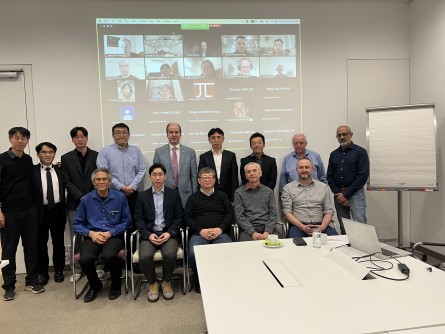The Korean Electronics and Telecommunications Research Institute (ETRI) is contributing to standards development for unmanned aerial vehicle communication networks according to a report published by Newswise and covered by UAS Vision.
The report says that four contributions related to the ‘Unmanned Aircraft Area Network’ were established as international standards at the recent International Organization for Standardization (ISO*) meeting in Vienna, Austria. The drone distributed communication standard technology is designed to prevent the risk of collision between drones when flying and supports the simultaneous operation of hundreds of drones.
The international standards cover four detailed technologies: ▲unmanned aerial vehicle communication model and requirements ▲shared communication ▲control communication ▲video communication.
The core technology of this international drone communication standards is Evolved Wireless Ad-hoc Network (EVAN) technology. The hyper-connected original technology was applied to the development of the international standards for this ‘unmanned aerial vehicle communication network’ and was recognized by standard experts around the world. EVAN, unlike LTE, is a modern communication network that uses an auxiliary channel that serves as a base station.
With the application of EVAN technology in the drone field, it became possible to share information between drones, prevent collisions between large-scale drones, and prevent collisions with ground movement obstacles based on it. The recognition service communication distance of this standard is about 5 km, which allows drones as well as drones and helicopters to be mutually recognized, thereby securing flight safety of manned and unmanned aircraft at the same time.
For example, it was difficult for drones from different manufacturers to fly to spray pesticides on large farmland simultaneously, or for several drones to fly over the fire area simultaneously in the event of a large fire, but the technology solved these problems.
In particular, the research team explained that compared to the heavy and expensive drone recognition radar, the communication modem of the ‘UAAN’ standard can be manufactured inexpensively, making it very suitable for drone recognition service.
In addition, ETRI explained that this standard technology enables interconnection of drones as well as related devices. In other words, drone-related services such as drone control and drone image transmission, mutual recognition between drones, autonomous collision avoidance, illegal drone detection, mobile obstacle recognition, and communication with takeoff and landing sites can be provided as an integrated communication platform.
The Korean research proposes autonomous collision avoidance between drones by utilizing the international standard for ‘Unmanned Aircarft Area Network’ and the ‘Low Altitude Unmanned Aircraft Detection and Avoidance Application Layer Technology’ standard of the Korea Telecommunications Technology Association(TTA).
Also, if the communication modem of this standard is installed on a moving obstacle that is not displayed on the map, it is of great help in autonomous drone flight. In addition, it supports services such as direct communication with Vertiport, a drone taxi take-off and landing site, and provision of flight priority (dynamic geofencing) when maintaining bridges or surveying buildings, and if applied to defense drones, it can overcome North Korea’s radio interference.
ETRI researchers explained that in this standard, since the drone transmits a password (trust field is similar to banking OTP technology) that changes with each signal transmission, it is possible to automatically determine whether the drone is a legitimate drone or an illegal drone from the ground.
Furthermore, it was disclosed that ETRI’s ‘Unmanned Aircarft Area Network’ standard can be utilized for PAV (Personal Air Vehicle) communication, such as drone taxis. Disconnection of the mobile communication network is fairly common in the air, unlike on the ground, and this standard is particularly ideal as a communication standard to supplement this. Internationally, communication redundancy is an essential requirement for Urban Air Mobility (UAM).
Lim Chae-deok, head of the Air Mobility Research Division at ETRI, said, “The establishment of this international standard will secure drone operation stability, which is essential for servicing commercial drones, while with EVAN technology, its core, it is easier to configure an adaptive communication network compared to mobile communication such as LTE and 5G and Wi-Fi and has high transmission efficiency, so it will be of great help in leading fast and convenient future air mobility services in the future.”
According to ETRI researchers, EVAN technology will be expanded to a single communication platform that will provide a variety of services such as home/home appliances/vehicle control, indoor navigation, smartphone kiosk connection, children’s safety on the way to and from school, cannon vehicle arrest, and search for missing persons.
For more information visit:




